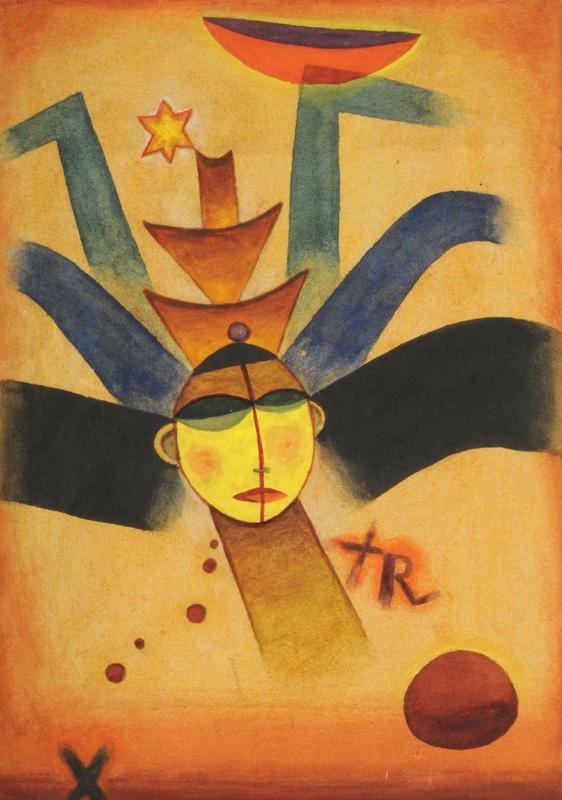Solari's Pupo takes its name from the word for "puppet" in one of his ancestral languages, Italian.
In medicine, PUPO means "pregnant until proven otherwise," which fits with Solari's esoteric attitude toward life. In his artwork, if Solari was anything at all, it was "pregnant"—with concepts, religions, fraternal oaths, symbols, languages, and even his own invented version of chess. When traveling through Europe, conversing in five European languages, he saw that many European painters were following Pablo Picasso in pursuing forms common to the traditions of indigenous communities. Authors note that Pupo, in keeping with the European style of the time, around WWI, appears to depict a pre-Columbian indigenous person with a headdress. As Loïs Mailou Jones noted in her interpretation of cubism, indigenous peoples are a central source of ideas for Europeans, though are often uncredited. Especially in the early days, it was obvious theft, but art writers called it "inspiration" because it breathed new life and ideas into the art world.
Andy Warhol, in typically cryptic language, once said native art is "the best art because it doesn't matter who made it." Of course, Warhol's statement could be an endorsement of the practice of stealing ideas from indigenous peoples, but it could also be a good observation about the way in which individual authorship and biography can get in the way of art practice. You know, the whole idea that it's much easier to dance in the dark, because you're less self-conscious. The fact that almost all of the greatest indigenous works—vintage kente cloth, for example, or the Easter Island stone statues—are unsigned, does not make them any less great, and does not justify stealing them by putting your own signature on them. Solari, however, interpreted indigeneity as a way of understanding his Americanness and the history of the Americas, and acknowledged an indigenous source of his ideas, unlike many of his contemporaries. Other works by Solari of the same period which evoke his reading of indigeneity include Frascos, Sol herido, and Reptil que sube.
The figure in Pupo emanates something, possibly words, which lead to an X symbol, which Solari considered sacred. It is worth noting that many chiefs and other indigenous treaty signatories signed their names with the X symbol. Where the Christian cross suggests verticality, the lines of heaven and earth, the X indicates the right angle, el derecho en español and the derech, the right path, in Hebrew.
Interpretation of the painting is not a major part of the writing on Solari's work, which fills many, many books, including one which translates Solari's invented language into English. Nonetheless, due to the central influence of theosophy's reading of kabbalah and mysticism on Solari, we might as well look at the Mogen Dovid, the ✡ hexagram at the top of the painting, above the headdress.
The tradition of Judaism teaches that we originated in the Middle East somewhere, although nobody was nearly as good at drawing borders in those days. This whole topic, understandably, is quite controversial, so I will just nod my head at it and choose the year 1008, the date which archaeologists ascribe to the Leningrad Codex, a copy of the TaNaKh, or five books of Moses. The beautiful codex contains the ✡ symbol as a decorative motif, which was also common in India, as the akarshan yantra, and in many other places. Unlike the menorah, the hexagram symbol belongs to many different cultures, but it came into vogue when we were living beyond the pale of settlement and needed a symbol to identify ourselves as an analogue to the Christian cross. Why did we need it? Well, they say the cross deters vampires, so maybe the ✡ does too.
In the current moment of "white" identity it is easy to forget that Solari was "multiethnic," being German, Italian, and born in Argentina more than 120 years ago. His use of the hexagram is like his use of Hebrew in his fiction, as in the story where an autobiographical character uses "false Hebrew" to summon a demon. "False Hebrew" would be some kind of mimicry based on the guttural, throat-clearing letter chet, as in Ch-anukah. Pantomiming Jews and natives are two ways in which Solari works out his own feeling of being a man of mixed ancestry.






















This painting has everything.